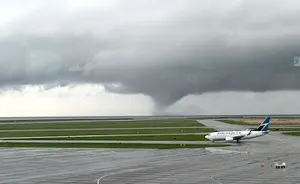
Scientists figure out how many birds are in the wild. What's your guess?
Scientists say there are a lot of birds flying around.
How many wild birds are there on the planet?
One billion? Maybe 100 billion?
The answer lies somewhere in between, according to a new study.
Scientists believe there are roughly 50 billion birds in the wild across 9,700 bird species, including flightless birds like emus and penguins. That's roughly six times as many birds as there are people on Earth, and the estimate was made by analyzing over a billion sightings logged on eBird, a database populated by citizen scientists, and a scaling algorithm.
Four bird species belong to ‘the billion club’: The house sparrow (1.6 billion), the European starling (1.3 billion), the ring-billed gull (1.2 billion), and the barn swallow (1.1 billion). Other birds, like Australia's black-breasted buttonquail, only have around 100 members left.
About 12 per cent of bird species recorded in the study have an estimated global population of less than 5000, researchers say.
Only 92 per cent of the bird species currently alive were included. The remaining 8 per cent were excluded because it is made up of rare species and lacking in data, and likely wouldn't have a big impact on the estimate.
There is some level of uncertainty with the findings. The '50 billion' figure is the median average, while the mean average is 428 billion.
Researchers hope to repeat the count every year to get an increasingly accurate count. They hope it will show population changes over time and shine a spotlight on conservation.
“We'll be able to tell how these species are faring by repeating the study in five or 10 years,” Associate Professor Will Cornwell, an ecologist at UNSW Science and co-senior author of the study, said in a statement.
“If their population numbers are going down, it could be a real alarm bell for the health of our ecosystem.”
The full paper can be found in PNAS.
RISKS TO BIRDS
In addition to climate change, invasive species, and habitat destruction, window collisions are a big threat to birds.
A 2014 study found between 365 million and one billion birds are killed by collisions with buildings each year in the U.S. alone. In Canada, about 25 million birds are killed annually from building collisions.
One simple way you can help birds is by reducing light pollution on your property. You can also help by keeping cats inside, because they're responsible for more than 100 million bird deaths annually in Canada.
Here are some tips to make your home safer for migrating birds, courtesy of Audubon:
Turn off bright outdoor lights. This can help a disoriented bird move on within minutes, the society says.
Turn off exterior decorative lighting, pot, and floodlights.
Reduce atrium lighting.
Use blinds to cover windows at night.
Down-shield exterior lighting. You are aiming to eliminate horizontal glare and upward-directed light.
Install automatic motion sensors.










